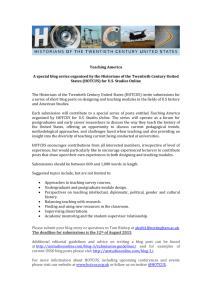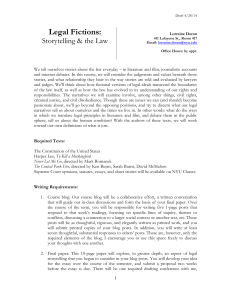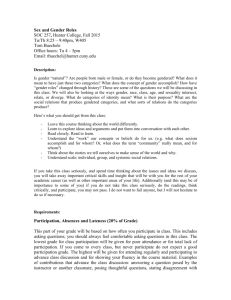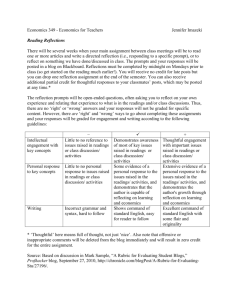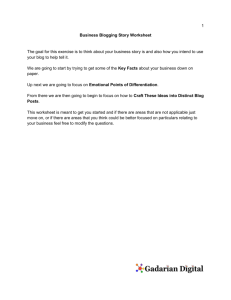MS Word version of the complete Syllabus for GSWS 002-601
advertisement
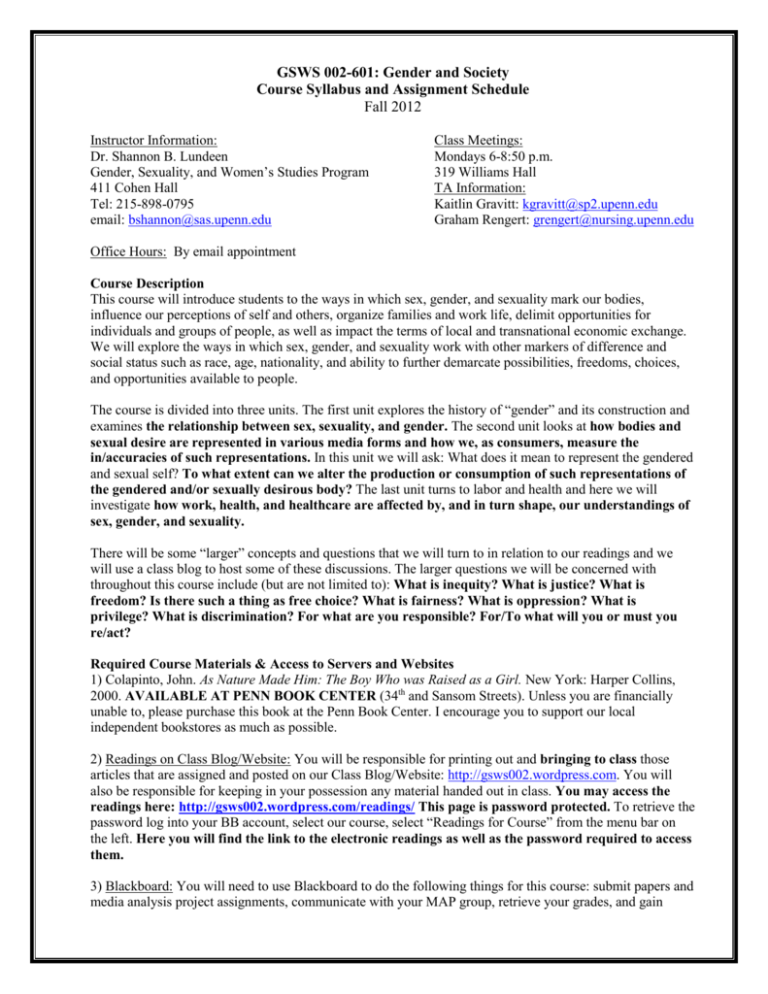
GSWS 002-601: Gender and Society Course Syllabus and Assignment Schedule Fall 2012 Instructor Information: Dr. Shannon B. Lundeen Gender, Sexuality, and Women’s Studies Program 411 Cohen Hall Tel: 215-898-0795 email: bshannon@sas.upenn.edu Class Meetings: Mondays 6-8:50 p.m. 319 Williams Hall TA Information: Kaitlin Gravitt: kgravitt@sp2.upenn.edu Graham Rengert: grengert@nursing.upenn.edu Office Hours: By email appointment Course Description This course will introduce students to the ways in which sex, gender, and sexuality mark our bodies, influence our perceptions of self and others, organize families and work life, delimit opportunities for individuals and groups of people, as well as impact the terms of local and transnational economic exchange. We will explore the ways in which sex, gender, and sexuality work with other markers of difference and social status such as race, age, nationality, and ability to further demarcate possibilities, freedoms, choices, and opportunities available to people. The course is divided into three units. The first unit explores the history of “gender” and its construction and examines the relationship between sex, sexuality, and gender. The second unit looks at how bodies and sexual desire are represented in various media forms and how we, as consumers, measure the in/accuracies of such representations. In this unit we will ask: What does it mean to represent the gendered and sexual self? To what extent can we alter the production or consumption of such representations of the gendered and/or sexually desirous body? The last unit turns to labor and health and here we will investigate how work, health, and healthcare are affected by, and in turn shape, our understandings of sex, gender, and sexuality. There will be some “larger” concepts and questions that we will turn to in relation to our readings and we will use a class blog to host some of these discussions. The larger questions we will be concerned with throughout this course include (but are not limited to): What is inequity? What is justice? What is freedom? Is there such a thing as free choice? What is fairness? What is oppression? What is privilege? What is discrimination? For what are you responsible? For/To what will you or must you re/act? Required Course Materials & Access to Servers and Websites 1) Colapinto, John. As Nature Made Him: The Boy Who was Raised as a Girl. New York: Harper Collins, 2000. AVAILABLE AT PENN BOOK CENTER (34th and Sansom Streets). Unless you are financially unable to, please purchase this book at the Penn Book Center. I encourage you to support our local independent bookstores as much as possible. 2) Readings on Class Blog/Website: You will be responsible for printing out and bringing to class those articles that are assigned and posted on our Class Blog/Website: http://gsws002.wordpress.com. You will also be responsible for keeping in your possession any material handed out in class. You may access the readings here: http://gsws002.wordpress.com/readings/ This page is password protected. To retrieve the password log into your BB account, select our course, select “Readings for Course” from the menu bar on the left. Here you will find the link to the electronic readings as well as the password required to access them. 3) Blackboard: You will need to use Blackboard to do the following things for this course: submit papers and media analysis project assignments, communicate with your MAP group, retrieve your grades, and gain access to any PowerPoints that I present in class. Please be sure that Blackboard has an accurate email address on file for you as I often send important emails to students via Blackboard. Log in to your UPenn Blackboard account with your Pennkey here: https://courseweb.library.upenn.edu/. 4) SAS Media Server: you will receive instructions in class on how to access and upload video content to https://media.sas.upenn.edu/ . You will need your Pennkey to access this server. Course Requirements Participation: 10% Blog Posts & Comments: 30% Analyze/Respond Papers (2): 30% (1 = 12% and 2 = 18%) Media Analysis Project: 30% (30% of this grade will be based on individual performance and 70% will be based on group performance unless you write the optional essay in which case your grade will be split 50 group/50 individual.) On discussion, participation, and attendance (10%): This class is a community in which we can develop our critical thinking skills. In order to be able to think critically about what we have read, we must first understand what we have read and be able to accurately explain the text’s main points and its logic. Some of the material is demanding and requires patience and often repeated readings. Prepare yourself by taking notes as you read (as well as in class). I expect you to come to class having read and thought about the assigned reading so that you are prepared to participate in discussion—any lectures in class will not take the place of, nor give a comprehensive summary of, the text assigned. I expect you to complete all of the reading assignments. The emphasis on writing and discussion will help you to develop your oral and written communication skills as well as your ability to understand complex arguments. I will keep a record of your attendance in class. Poor attendance will not only be reflected in my record of your presence in class, but in your participation grade as well as in your quiz scores as you cannot make up a quiz unless you have a medical or family emergency and a note from a medical doctor or family guardian backing it up, and give such documentation to me in the class directly following the one that you missed. No exceptions will be considered. Unless your absence is due to a documented medical or family emergency, you are responsible for turning in (electronically, if need be) an assignment BEFORE the start of the class on the day it is due. You will be given one, no-questions-asked unexcused absence per semester. This absence will not negatively impact your grade as long as it is not on the day of a quiz, written assignment, or group presentation. You get one of these for the whole semester, including add/drop days at the beginning of the course. Each subsequent unexcused absence will result in the lowering of your participation grade by one-half of a letter grade. However, IF YOU HAVE THREE OR MORE UNEXCUSED ABSENCES YOU WILL FAIL THE COURSE. Excused absences include observance of religious holidays, participation in athletic events, job or graduate school interviews for seniors (2 maximum per student for interview-related absences). For ANY/ALL of these types of absences to be considered excused, you must inform me of your absence no later than the class prior to your absence. Emailing me the day before or telling me after the class you missed will result in your absence being unexcused. On blog posts and comments (30%): In a place noted on the reading and assignment schedule, you will be invited to create one “big question” reflection in relation to particular readings on our class blog and one “spark post”. You must write a total of two big question reflections and two spark posts. The time and date of your other big question GSWS 002-001 Syllabus, Lundeen, Fall 2012 2 reflection and spark post will be determined by you. These posts will be graded on a scale of 0-4 (see below for more detail on the grading scale for big question posts). You will also be required to post a critique of an advertisement/commercial and include the photo, video, or link to the ad/commercial in your post. You will be given more explicit instructions for this assignment in class (see schedule below for the due date for this post). You need to comment on the posts of others three times throughout the semester; you will be invited to comment one time on the assignment schedule but you may determine the time you submit the other required two comments. Comments will be graded on a scale of 0-2 (see below for more detail on the grading scale for comments). Required posts & comments: - Two big question reflection posts (one post must be done on a particular day/time as noted in the schedule) (4.5% each) - Two spark posts (one post must be done on a particular day/time as noted in the schedule) (4.5% each) - One ad critique post (see assignment and reading schedule for the due date) (4.5% each) - Three comments on others’ posts (one comment bust be done on a particular day/time as noted in the schedule) (2.5% each) Non-required posts & comments: You may comment on others’ posts more than three times. You may post more than 2 big question reflections, 2 spark posts, and 1 ad critique. Any posts/comments AFTER you have submitted the required number cannot be used to replace your earlier posts/comments but so long as your non-required posts merit at least a “3” and your non-required comments merit a “2,” such additional participation on our class blog will boost your overall participation grade for the course. For all posts/comments: You must follow the expectations and guidelines for particular types of posts available on our class website and below in this syllabus. Class Blog Guidelines for Posting and Commenting: Categorize your post! Available categories are: “big question reflection,” “spark post,” and “ad critique.” Do not use the “uncategorized” category. Be sure to follow the requirements for these posts (see below.) Tag your posts with at least one tag that identifies a topic or key word in your post. When you are composing/editing a post you will see a word count at the bottom of the post window. Use this to determine if you are in the acceptable range of words for spark posts and big question reflections before you publish your post. Do not include any personal contact information in your posts. Abbreviations, shortcuts, and txt language should be left to cell phones, electronic chatting and instant messaging services, and the like. Please practice accurate grammar, punctuation, and spelling on our class blog. Our class blog is a public site. Only students in our class, our TAs, and I will have the ability to post things, but anyone with Internet access can see what we’ve posted. Keep this in mind each time you submit a post. Do not link to pages or external sources that you have not completely read. Do not post photos or videos of others without their permission – photos and videos already posted online in a public forum may be re-posted on our blog only if such images and videos are declared by their owner to be freely available for such re-postings (please note: making a link to any publicly accessible webpage and including the title of the page is always acceptable.) Consult these copyright and fair use guidelines. The purpose of this blog is to increase dialogue and communication. Please keep this intention in mind and avoid submitting posts that may work to silence others. GSWS 002-601 Syllabus, Lundeen, Fall 2012 3 When commenting, show others that you have read their post. Responses such as “Yeah!” or “Nice work!” are insufficient. Be prepared for disagreements and be open to having your classmates challenge your position. Descriptions and Requirements for Student Posts and Comments: All of your posts must include text and may also include external links and, when it does not violate copyright law and constitutes fair use, photos, videos, or music files. 1. Big Question Reflection: 100-200 words, exclusive of citations, source attributions, and links. Take one of the “big questions” (What is inequity? What is justice? What is freedom? Is there such a thing as free choice? What is fairness? What is oppression? What is privilege? What is discrimination? For what are you responsible? For/To what will you or must you re/act?) and tailor your answer to it in relation to the specific issues, concerns, and themes that we have been learning about and grappling with thus far in the semester. Your answer should include a text response but it does not need to be limited to this; indeed, you may want to use a particular event or story to frame your response by including and referencing a link to an external site or page that gives us more information about it. Alternatively, you may want to share a song or other audio file that frames your textual response to one of the “big questions.” Cite any sources used. 2. Spark Post: 100-200 words, exclusive of citations, source attributions, and links. Students should submit something that will spark discussion for us and command our attention! Your post must have something to do with gender or sexuality and may also relate to the broader themes of the class. Specific reference to course materials including direct quotations is welcomed. Cite any sources used. 3. Ad Critique: Consists of 75-200 words, exclusive of citations, source attributions, and links. Your post should provide a critical assessment of the portrayal of sex, gender, and/or sexual desire (you may include more markers of difference in your analysis when applicable) in a print advertisement or television commercial (embed them or hyperlink them in your post). You must refer to course material to support your argument or use your critique to refute claims made by authors whose work we’ve read in class. Cite any sources used. Pay attention to setting, props, dialogue or ad copy, subjects, product being advertised, clothing, physical posturing, behavior, and the placement of the ad/commercial in the larger context of the host network or host print publication. What values are being sold or marketed as desirable and to whom? Attempt to identify the target audience of the ad – how does this audience influence your critique of the portrayal of sex, gender, or desire in the ad? 4. Comment: no minimum or maximum word requirement but your comment should be fully fleshed out and demonstrate engagement with the original post. “Totally” is not an acceptable comment. If you have the urge to write “totally,” replace “totally” with an explanation for why you agree with the claims/points made by that person’s post and why you think s/he is “totally” correct. If you can offer additional evidence for your support of his/her claim, it will work to strengthen his/her original argument/claim. Cite any sources used. Grading Scales1 for Posts and Comments Grading Scale for Student Blog Posts: 4 Exceptional: The submission is focused and coherently integrates examples (examples may include descriptions of experience, links, photos, or videos) with explanations or analysis. The entry demonstrates awareness of its own limitations or implications, and it considers multiple perspectives when appropriate. The entry reflects in-depth engagement with the topic. 1 This rubric is based on Professor Mark Sample’s grading rubric for assessing students’ weekly posts on his class blogs. It has been adapted slightly to suit the needs of this class. GSWS 002-601 Syllabus, Lundeen, Fall 2012 4 3 Satisfactory: The submission is reasonably focused, and explanations or analysis are mostly based on examples or other evidence. Fewer connections are made between ideas, and though new insights are offered, they are not fully developed. The entry reflects moderate engagement with the topic. 2 Underdeveloped: The submission is mostly description or summary, without consideration of alternative perspectives, and few connections are made between ideas. The entry reflects passing engagement with the topic. 1 Limited: The submission is unfocused, or simply rehashes previous comments, or only consists of a photo, a video, or a link, and displays little evidence of student engagement with the topic. 0 No Credit: The submission is missing or consists of one or two disconnected sentences. Grading Scale for “Comments”: 2 Comment is fully fleshed out and explains why you like/agree with/disagree with the post on which you are commenting. Comment demonstrates engagement with the content of the original post and challenges particular points and/or strengthens particular elements of the original post. 1 Comment reflects support of or challenges the original post but does not offer sufficient explanation for support/disagreement. 0 Did not post a comment. On Analyze/Respond Papers (Paper 1 = 12%; Paper 2 = 18%; Total = 30%) I will assign these three times throughout the semester. You must write the first paper that is assigned and then you may choose to write either the second or the third paper that is assigned. You may not turn in three papers. There will be a few times throughout the semester that I will offer extra credit to boost your 1st or 2nd paper grade. Each time, I will ask you to apply a particular question set to two or three texts from the Unit we just completed. It will be your job to a) write about how the authors answer or respond to this particular set of questions in their texts and b) discuss how the authors’ treatments of the question influence your response to this particular set of questions. The paper must be typed in Times New Roman size 12 font, double-spaced, and 3-4 pages in length. More detailed instructions will be given at the time the papers are assigned. Please note that you must submit these papers as Microsoft Word documents on Blackboard before class on the day they are due. If you have any trouble uploading your paper to BB, please send a copy to both Kaitlin and Graham before class on the day the paper is due. On the Media Analysis Project (30%) You will create media with an original message by creating a five-minute video. The goal of this project is to apply what you’ve learned about the relationship between gender and sexuality in order to critique a particular item/set of items in the media and to offer us something new that directly challenges what your group is critiquing. “Media” is to be broadly interpreted: you may use film, television (e.g., commercials, sitcoms, news broadcasts), print advertisement, etc. You may use current media or historical media. You will be assigned to a group for this project early on in the semester. Your video can be original footage, it can be a mash-up of previously recorded videos, it can be a recording of an original performance, of voice-overs and still images, of PowerPoint slides, etc. You must have a video version of your final project that can be made available for public consumption on YouTube or on the Weigle Information Commons’ server as you must intend to reach a wide audience with this project/creation. Your video draft and final video must be uploaded to the SAS Media Server (if you upload it on to YouTube you still must load a copy on the SAS Media server). You will be given instructions on how to do this in class. GSWS 002-601 Syllabus, Lundeen, Fall 2012 5 Possible mediums for your final projects include: Performance (drama, comedy, etc. video recorded and may be performed live on student presentations day as long as the performance does not exceed 5 minutes) Video (can be original footage, a mash-up, a combination of stills and video w/ narration, etc.) Song/Musical creation (3-5 minutes in length or two shorter songs, must have a “music video” version of this) Public Service Announcement/Education Campaign (5 minute max) Ad campaign (print -5 different ads for the same product/idea; or commercial – 5 minute video total, can be divided into 2-3 shorter commercials) Artwork (difficult to quantify any sort of “length” so please consult with Prof. Lundeen on a group by group basis) the video production of this should document the process of its creation and include your reasoning throughout its development. In any of the mediums above, the following elements must be evident to your audience: Identification of the conventional narrative or representation you are challenging Analysis of media object(s) and its corresponding conventional narrative/representation Thesis or main argument that is supported through your critique Critique of the object(s) and the narrative/representation Creation and/or Contribution that offers an alternative or disruptive narrative Invitation/Provocation/Incitation to your audience to “buy in” to your alternative or disruptive narrative and/or to “do something” as a result of your video. The evaluation of this project will involve individual and group components. This project entails seven requirements: 1) Written reflection on the process of choosing a media object; 2) Group project proposal and individual contribution proposals; 3) Video draft; 4) Self-critique of video draft 5) Peer review of another group’s video draft 6) Video 7) Corresponding Essay (optional) The due dates and grade weights are as follows: Fri, Oct 5th: Reflection on media object(s) choice (5% individual grade) uploaded to BB. Fri, Oct 19th: Group and Individual Project Proposals (5% individual grade; 5% group grade) hard copies of the proposals should be turned in at the start of class. Sat, Nov 17th: Video Draft (15% group grade) uploaded to SAS media server. Wed, Nov 21st: Self Critique of Draft (10% individual grade) uploaded to BB. Wed, Nov 21st: Peer Review of Video Draft (email the designated group member and copy Dr. Lundeen on the email): (10% individual grade) Mon, Dec 17th: By 5:00 p.m. Final Video uploaded to SAS Media server (and YouTube if possible); 6-7:30 p.m. Public Viewing – invite your friends and family! (30% group grade) Mon, Dec 17th: Optional Accompanying Essay - each student submits one in class and on BB before the start of class (20% individual grade; if this is not turned in, the video will count for 50% of your total MAP grade instead of 30%.) You will be given more specific instructions before each requirement is due. Class Decorum You are expected to attend every class session and arrive promptly at 6:00 p.m. on Mondays. Since the primary format of the class will be discussion, you are expected to be respectful of each person’s opinion which, among other things, involves listening to your fellow classmates while they hold the floor in a discussion. If you choose to engage in any form of disruptive behavior during our class time you will be asked to excuse yourself from the class. All cell phones and personal electronic devices must be turned to silent or vibrate upon entering the classroom and you must put them out of your sight and touch. I do not allow the use of laptop computers in the classroom except when I explicitly invite you to use them. Unless you have a disability that prevents you from doing so, you must take notes by hand. GSWS 002-601 Syllabus, Lundeen, Fall 2012 6 Plagiarism All Academic Dishonesty offenses are reported to the University’s Office of Student Conduct. What is plagiarism? Plagiarism occurs when you use another’s words, ideas, assertions, data or figures and do not acknowledge that you have done so. In simple terms, plagiarism is a form of theft. If you use the words, ideas or phrasing of another person or from published material, you must: Use quotation marks around the words and cite the source. Alternatively, you may paraphrase or summarize acceptably and cite the source. If you use charts, graphs, data sets or numerical information obtained from another person or from published material, you must also cite the source. Whether you quote directly or paraphrase the information, you must acknowledge your sources by citing them. In this way, you have the right to use another’s words by giving that person credit for the work he or she has done. You must provide accurate source attribution in your essays, your blog posts, and your videos for this class. An act of plagiarism will result in a failing grade for that assignment and depending upon the degree of severity, may result in a failing grade for the course. For the University of Pennsylvania’s Code of Academic Integrity go to: http://www.upenn.edu/academicintegrity/ai_codeofacademicintegrity.html For the University of Pennsylvania’s policy on violations of academic integrity go to: http://www.upenn.edu/academicintegrity/ai_violations.html For more resources on how and when to cite sources, visit: http://www.upenn.edu/academicintegrity/ai_citingsources.html Blackboard This class is registered on Blackboard. To login to your Blackboard account, go to https://courseweb.library.upenn.edu/. You will be able to use Blackboard to access grades, upload assignments, view power point presentations and communicate with your group members about your media analysis project. Information to Students with Disabilities The University of Pennsylvania welcomes students with disabilities and provides reasonable accommodations to those who self-identify in compliance with Section 504 of the Rehabilitation Act and the Americans with Disabilities Act. Academic accommodations, auxiliary services , and technology are made available to students who meet established documentation guidelines. Policies and procedures have been developed to provide students with as much independence as possible, to promote self-advocacy, and to provide students with disabilities the same exceptional opportunities available to all Penn students. Student Disabilities Services and the Office of Learning Resources are located at Stouffer Commons, 3702 Spruce Street, Suite 300. (The entrance is on Woodland Walk.) Phone: 215-573-9235 (voice); 215-746-6320 (TDD); web address is: http://www.vpul.upenn.edu/lrc/sds/. GSWS 002-601 Syllabus, Lundeen, Fall 2012 7 GSWS 002-601 GENDER AND SOCIETY ASSIGNMENT AND READING SCHEDULE **The following dates are the dates on which the assignment is due/must be completed.** WS = on website – you will find the readings at http://gsws002.wordpress.com/readings/ UNIT 1: (De)constructing Sex and Gender 1. Monday, September 10th Introduction to the course 2. Monday, September 17th Join our class blog by creating a wordpress account and accepting my invitation. (You should have received an email inviting you to join Gender and Society Fall 2012 – follow the links in the email.) WS: Judith Lorber, “The Social Construction of Gender” (1990) WS: Lois Gould, “X: A Fabulous Child’s Story” (1978) WS: News articles/clips on “genderless” children: Pop (http://www.thelocal.se/20232/20090623/) (2009) Storm (http://abcnews.go.com/GMA/video/inspiration-genderless-child-13718080) (2011) Sasha http://www.foxnews.com/world/2012/01/20/british-couple-reveals-sex-child-raised-as-genderless-for-5-years/ (2012) WS: Simone de Beauvoir, “Introduction” to The Second Sex (1949) WS: bell hooks, “Sisterhood: Political Solidarity between Women” (1986) WS: Gloria Anzaldúa, “La conciencia de la mestiza: Towards a new consciousness” (1987) Wednesday, September 19th By 11:59 pm tonight: If your last name begins with A-F: post a big question reflection in relation to the readings from September 17th on our class blog. Friday, September 21st By 11:59 pm tonight: If your last name begins with T-Z: post at least one comment on one of the “big question reflections” that your peers posted on Wednesday. 3. Monday, September 24th WS: Judith Butler’s, “The Compulsory Order of Sex/Gender/Desire” and “Gender: The Circular Ruins of a Contemporary Debate” (excerpts from Gender Trouble.) (1990) WS: See also Notes for Butler and Glossary for Butler WS: Christine Delphy, “Rethinking Sex and Gender” (1993) Recommended on WS: Julia Serano, “Experiential Gender” (2007) WS: Anne Fausto-Sterling, “Should There Be Only Two Sexes?” (2000) WS: Journal of Genetic Counseling Commentaries on Caster Semenya and Gender Verification Testing (2010) Media analysis groups assigned today: Check Blackboard for your group information. Wednesday, September 26th By 11:59 pm tonight: If your last name begins with G-M: post a big question reflection in relation to the readings from September 24th on our class blog. Friday, September 28th By 11:59 pm tonight: If your last name begins with A-F: post at least one comment on one of the “big question reflections” that your peers posted on Wednesday. 4. Monday, October 1st John Colapinto, As Nature Made Him, entire book, including the epilogue, afterword, and the P.S. section First Analyze/Respond Paper will be assigned in class today. Media Object Choice Reflection Assignment discussed today (accessible on BB). Wednesday, October 3rd By 11:59 pm tonight: If your last name begins with N-Z: publish a spark post on our class blog. GSWS 002-601 Syllabus, Lundeen, Fall 2012 8 Friday, October 5th By 11:59 pm tonight: Individual reflection on group object choice for media analysis project must be posted on BB UNIT 2: Representing Gendered Bodies & Sexual Desire 5. Monday, October 8th *Class will be held in Weigle Info Commons in Van Pelt Library* Introduction to Unit 2 First Analyze/Respond Paper due on BB before class. **iMovie Tutorial in class today: you must bring the laptops to class that you’re using for your video projects*** WS: Jean Kilbourne, “Buy this 24-year old and get all his friends absolutely free” (1999) WS: John Berger, excerpt from Ways of Seeing (1972) In-Class film: “Killing Us Softly 4” (2010) Sunday, October 14th By 11:59 pm tonight: EVERYONE MUST Upload to our class blog a photo or video of an advertisement or television commercial along a critique of the advertisement/commercial. Requirements: Post consists of 75-200 words, exclusive of citations, source attributions, and links. Your post should provide a critical assessment of the portrayal of sex, gender, and/or sexual desire (you may include more markers of difference in your analysis when applicable) in a print advertisement or television commercial (embed them or hyperlink them in your post). You must refer to course material to support your argument or use your critique to refute claims made by authors whose work we’ve read in class. Cite any sources used. Pay attention to setting, props, dialogue or ad copy, subjects, product being advertised, clothing, physical posturing, behavior, and the placement of the ad/commercial in the larger context of the host network or host print publication. What values are being sold or marketed as desirable and to whom? Attempt to identify the target audience of the ad – how does this audience influence your critique of the portrayal of sex, gender, or desire in the ad? 6. Monday, October 15th WS: Sharlene Nagy Hesse-Biber, “Selling the Body Beautiful: Food Dieting, and Recovery” (2007) WS: Susan Bordo, “Reading the Slender Body” (1993) WS: Marilyn Wann, “Fat Studies: An Invitation to Revolution” (2009) WS: Wan-Hsiu Sunny Tsai, “Assimilating the Queers: Representations of Lesbians, Gay Men, Bisexual, and Transgender People in Mainstream Advertising” (2010) Friday, October 19th By 11:59 pm tonight: individual and group media analysis project proposals must be posted on BB No class Monday, October 22nd: Fall Break Friday, October 26th By 11:59 pm tonight: If your last name begins with A-M: publish a spark post on our class blog. 7. Monday, October 29th WS: Samuel A. Chambers, “Heteronormativity and the L-Word” (2006) WS: bell hooks “The Oppositional Gaze: Black Female Spectators” (originally pub 1992; 2003) WS: Patricia Hill-Collins, “Booty Call: Sex, Violence, and Images of Black Masculinity” (2005) In-class film: Dreamworlds 3 (2007) Wednesday, October 31st By 11:59 pm tonight: If your last name begins with T-Z: post a big question reflection in relation to the readings and film from October 8th through October 29th on our class blog. Friday, November 2nd By 11:59 pm tonight: If your last name begins with N-S: post at least one comment on one of the “big question reflections” that your peers posted on Wednesday. GSWS 002-601 Syllabus, Lundeen, Fall 2012 9 8. Monday, November 5th WS: Drucilla Cornell, “Introduction” in Feminism and Pornography (2000) WS: bell hooks, “Seduced by Violence No More” (1994) WS: Rachel Kramer Bussel, “Beyond Yes or No: Consent as Sexual Process” (2008) In-class film: TBA but will feature sexually explicit material Analyze/Respond Paper #2 assigned in class today. UNIT 3: Gendered Borders: Labor and Health 9. Monday, November 12th Introduction to Unit 3: Gendered Labor and Gendered Health Unit 2 Assessment: Second Analyze/Respond Paper due on BB before class today. WS: Sheila Jeffreys, “Keeping Women Down and Out: The Strip Club Boom and the Reinforcement of Male Dominance” (2008) WS: Ehrenreich and Hochschild, “Global Woman” (2003) In-Class film: “Live Nude Girls Unite!” (2000) Saturday, November 17th: Draft of Video Mash-up uploaded to SAS Media Server by 11:59pm tonight. 10. Monday, November 19th WS: Ruth Cowan, “Household Technology and Household Work between 1900 and 1940” (1983) WS: Lisa Belkin, “When Mom and Dad Share It All” (2008) WS: Ehrenreich & English “The Sexual Politics of Sickness” (1978) WS: Ellen Samuels, “My Body, My Closet: Invisible Disability and the Limits of Coming-Out Discourse” (2003) Wednesday November 21st : Draft Critique and Peer Review uploaded to BB by 11:59 p.m. tonight 11. Monday, November 26th WS: excerpt from Shulamith Firestone’s The Dialectic of Sex (1970) WS: Angela Davis, “Racism, Birth Control and Reproductive Rights” (1981) WS: NY Times article on Swedish parental leave policy: http://www.nytimes.com/2010/06/10/world/europe/10ihtsweden.html?pagewanted=all In-Class Film: The Business of Being Born (2007) Wednesday, November 28th By 11:59 pm tonight: If your last name begins with N-S: post a big question reflection in relation to the readings and film from November 12th through October 26th on our class blog. Friday, November 30th By 11:59 pm tonight: If your last name begins with G-M: post at least one comment on one of the “big question reflections” that your peers posted on Wednesday. 12. Monday, December 3rd WS: Dean Spade, “Resisting Medicine, Re/modelling Gender” (2003) WS: Karin Martin, “William Wants a Doll. Can He Have One? Feminists, Child Care Advisors, and Gender-Neutral Child Rearing” (2005) WS: Dean Spade, “About Purportedly Gendered Body Parts” (2011) In class film: Diagnosing Gender (2011) Wednesday, December 12th Upload to BB the Third Analyze/Respond paper by 11:59 pm tonight. 13. Monday, December 17th: 6-8 pm, room TBA Presentations of Videos: by 5:00 p.m. upload your FINAL video mash-up to SAS media server and upload to BB your corresponding individual essay if you wrote one. PLEASE INVITE YOUR FAMILY AND FRIENDS TO ATTEND THIS VIEWING! GSWS 002-601 Syllabus, Lundeen, Fall 2012 10
